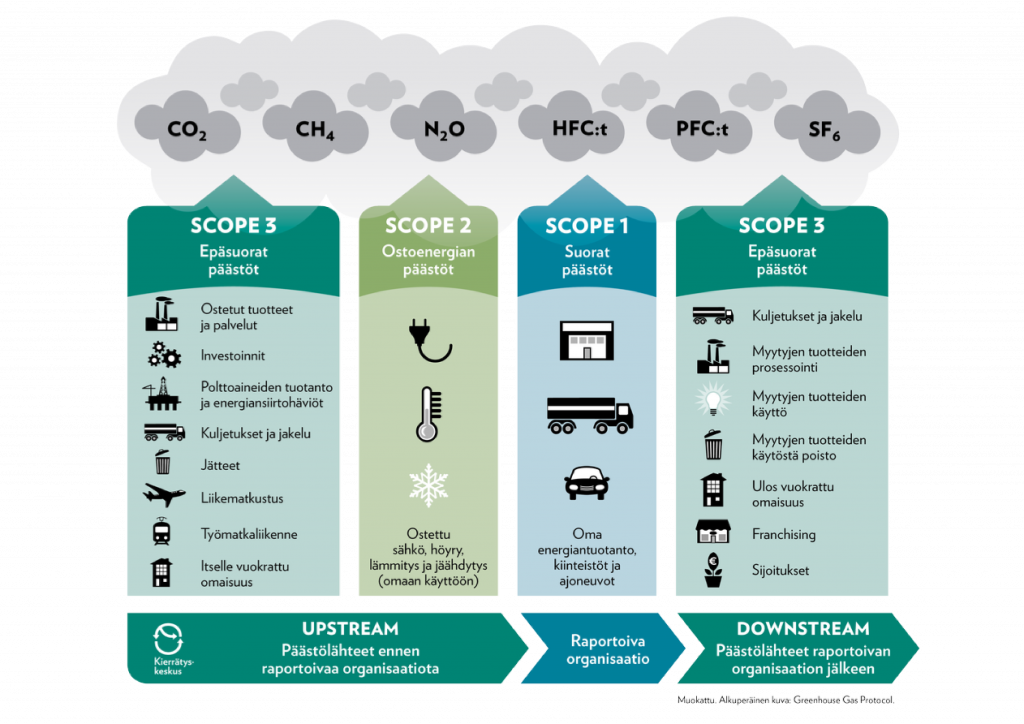 Carbon footprint = greenhouse gas emissions produced by the product/activity/organisation converted into carbon dioxide equivalents (CO2e).
Carbon footprint = greenhouse gas emissions produced by the product/activity/organisation converted into carbon dioxide equivalents (CO2e).
Carbon sink = a function that absorbs carbon, e.g. plants, forests, seas etc.
Carbon neutrality = the amount of greenhouse gas emissions by a product/activity/organisation does not exceed the amount it can absorb by carbon sinks.
Carbon negativity (= being climate positive) = a product/activity/organisation removes carbon from the atmosphere, i.e., in practice, absorbs more carbon than it releases into the atmosphere.
Emission factor = GHG emissions caused by a product or service in CO2 equivalents in relation to the functional unit.
Examples of emission factors:
Beef: 24.9 kg CO2e/kg
Petrol: 2.07 kg CO2e/kg
Burnable waste: 105.4 kg CO2e/kg
Driving a car: 159 g CO2e/kg
Why should the carbon footprint be calculated?
- The State of Finland aims is to be carbon neutral in 2035.
- The City of Turku has set as its goal to be carbon neutral in 2029 and to remain climate positive (i.e., carbon negative) from then on. Video: Will Turku be carbon neutral in 2029?
- Legislation and other requirements will change and become stricter
- To reduce climate impacts, we must know what the emissions consist of. This makes it possible to carry out cost-effective and correctly selected measures and monitor their impact.
Calculating the carbon footprint
There are international standards for calculating the carbon footprint, such as Greenhouse Gas Protocol (GHG protocol) (the most commonly used) and ISO 14067.
According to the GHG protocol, emissions are divided into three categories (Scopes 1–3)
-
- Scope 1: direct emissions i.e., fuels and own energy production
- Scope 2: emissions from purchased energy
- Scope 3: indirect emissions
 Image source: Ekokompassi
Image source: Ekokompassi
Challenges in calculating the carbon footprint
It is not possible to directly compare the carbon footprints of different organisations because they may have been calculated using different methods, limit values and coefficients.
The availability of reliable emission factors is challenging. Emission factors have not even been calculated for all products. In addition, the emission factors reported by companies for their own products may be unreliable and biased.
The general rule to remember is that the carbon footprint is always an estimate, not an absolute truth.
TAI’s carbon footprint
TAI’s carbon footprint has been calculated for 2021 and 2022. To get a realistic picture of the carbon footprint, it must be calculated for several years. In 2021, the COVID-19 pandemic affected the carbon footprint, for example, by reducing commuting. TAI’s carbon footprint was calculated using a calculator developed in the VASKI project.
In 2021, TAI’s carbon footprint was approx. 11,200 t CO2e and in 2022 approx. 10,700 t CO2e. Most of the emissions were generated from heating schools and procurement. TAI’s carbon footprint will decrease significantly when the new modern TAITO campus is completed.


Personal carbon footprint
The average carbon footprint of Finns is around 9600 tn CO2e per year. Most of it comes from living, moving and eating.
You can calculate your personal carbon footprint using a lifestyle test developed by Sitra (available in Finnish only). The test also provides tips on how to reduce the emissions produced by your lifestyle. Tip: the lifestyle test can also be used in teaching sustainable development!
